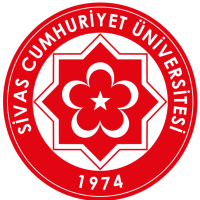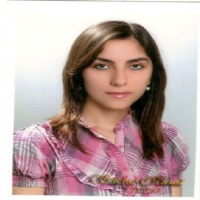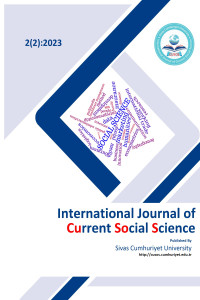Research Article
Aim & Scope
“International Journal of Current Social Science” (CUSOS) is published by Sivas Cumhuriyet University, Cumhuriyet Vocational School of Social Sciences. Scientific research and publication ethics principles are prioritized in the studies to be prepared. It is aimed to spread scientific production and participation to academic units and to reflect the publication characteristics of the branches of science objectively.
The following topics and their sub-sections will be evaluated:
- Banking and Insurance
- Labor Economics and Industrial Relations
- Econometrics
- Communication
- Economy
- Business
- Public Administration
- Finance
- Healthcare Management
- Tourism
- Management Information Systems
- International Trade and Logistics
The International Journal of Current Social Science (CUSOS) includes articles on theoretical and applied social science research, as well as reviews. The main purpose of this periodical is to disseminate current research results, new theories and approaches as well as information about professional activities to wider audiences and geographies.
The International Journal of Current Social Science (CUSOS) is an online journal designed to support the development of social sciences. Articles by local and foreign authors on contemporary achievements, innovative ideas and future perspectives in the field of scientific and applied social sciences will be published in the CUSOS journal.
Author Guidelines
The authors should pay attention to these subjects:
• Please prepare your submission according to the journal rules.
Especially, make sure that the references section is prepared according to the rules of the journal.
Please know that SUBMISSIONS NOT PREPARED ACCORDING TO JOURNAL rules will CAUSE LATE EVALUATION.
• Please make sure that the references in your submission and in the reference section are compatible.
We recommend that you check your submission carefully in terms of references before submit your submission.
• Please check your submission in terms of similarity index before submit.
Please remember that the HIGH SIMILARITY INDEX will cause DECLINE of your submission directly according to journal rules.
Before submission of the new manuscript authors should consider the following general rules for preparation of the manuscript. Please read these instructions carefully and follow the guidelines strictly.
• Fonts: Important – Use Times or Times New Roman 12 point size only (other sizes as specified), and Symbol font for mathematical symbols (in the text and in the figures).
• Justification should be set to full (or left only, if preferred).
• Do not underline: Use italics, bold or bold italics instead.
• Line spacing should be set at 2 (Double).
• Leave a line space between paragraphs and sections.
• Leave a line space between section titles and text.
• Leave only one space after a full stop.
• Manuscripts must be typed on A4 (210 × 297 mm) paper, double-spaced throughout and with ample margins of at least 2.5 cm. All pages must be numbered consecutively. Starting with the title page as p.1, the text, which begins with p.2, is to be arranged in the following order:
abstract, brief introduction, materials and methods, results and discussion, acknowledgements, references, figure legends, tables.
• The first page of the full manuscript must begin with the title of the paper centered on the page in 14 point Bold Title Case (title case means first letter of each main word capitalized), the names of the authors (Initials – followed by a period each – Family Name) with the main author’s name mentioned first, the names and locations of the authors’ affiliations (Title Case), and the e-mail address of the main author. The title page must provide the title in English, a short title of not more than 45 characters (including spaces) to be used as running head, up to five topical key words in English for subject indexing, the full postal address of the corresponding author to whom proofs will be sent. The title should be brief and should indicate the species studied. Subtitles are not encouraged.
• The abstract should not exceed 300 words, should be one paragraph and should be free of references and abbreviations. It should indicate clearly the scope and main conclusions of the paper.
• The introduction should give the pertinent background to the study and should explain why the work was done.
• The materials and methods (or methodology) should give essential details, including experimental design and statistical analysis.
• The results should present the findings of the research. They should be free from discussion. Results should be written in the past tense.
• The discussion should cover, but not simply repeat the new findings and should present the author's results in broader context of other work on the subject interpreting them with a minimum of speculation.
• The acknowledgements should be as brief as possible.
List of References
• The list of references appears at the end of your work and gives the full details of everything that you have cited in the text in alphabetical order by the author’s surname.
• All sources must be referred in a consistent manner. Choose from the list of sources below, the examples given, provide a guide to the format and punctuation you should use.
• Citation in The Text
(Taşkın, 2013; Taşkın et al., 2015; Taşkın et al., 2016; Taşkın and Büyükalaca, 2017)
In a study carried out by Taşkın (2013)
In a study carried out by Taşkın and Büyükalaca (2017)
In a study carried out by Taşkın et al. (2015)
• Journal Article (Print)
Taşkın H, Büyükalaca S, Doğan HH, Rehner SA, O’Donnell K. 2010. A multigene molecular phylogenetic assessment of true morels (Morchella) in Turkey. Fungal Genetics and Biology, 47: 672-682. doi: 10.1016/j.fgb.2010.05.004
• Journal Article (Electronic)
Taşkın H, Baktemur G, Kurul M, Büyükalaca S. 2013. Use of Tissue Culture Techniques for Producing Virus-Free Plant in Garlic and Their Identification Through Real-Time PCR. The Scientific World Journal, DOI: https://doi.org/10.1155/2013/781282
• Book
Stamets P. 1993. Growing Gourmet and Medicinal Mushrooms. Berkley: Ten Speed Press. ISBN 0-89815-608-4.
• Book Chapter
Taşkın H, Büyükalaca S. 2017. Minimally Processed Mushrooms. In: Yildiz F, Wiley RC (editors). Minimally Processed Refrigerated Fruits and Vegetables. Boston, MA: Food Engineering Series, Springer. pp. 433-468. ISBN: 978-1-4939-7016-2 (Print) 978-1-4939-7018-6 (Online).
• Conference Papers
Taşkın H, Keleş D, Baktemur G, Büyükalaca S. 2016. Scientific Contributions to Anther Culture of Pepper from Turkey.In: Ertsey-Peregi K, Füstös Z, Palotás G, Csilléry G (editors). Proceedings of XVIth EUCARPIA Capsicum and Eggplant Working Group Meeting, Kecskemét, Hungary, 12-14 September 2016, Diamond Congress Ltd., pp. 568-573.
• Dissertation/Thesis
For PhD/ Doctor of Philosophy
Taşkın H. 2011. Molecular Characterization of Morchella spp. in the Flora of Turkey. PhD Dissertation. Institute of Natural and Applied Sciences, Cukurova University, Adana, Turkey.
For MSc/ Master of Science
Taşkın H. 2005. Different Applications to Improve the Embriyo Quality on Stimulation of Embryo by Anther Culture in Some Pepper Genotypes. MSc Thesis, Institute of Natural and Applied Sciences, Cukurova University, Adana, Turkey.
• Internet Sources
FAO, 2017. Food and Agriculture Organization of the United Nations. FAOSTAT. Available from: http://www.fao.org/faostat/en/#data/QC [Accessed 28 February 2020]
Abbreviations and Units
Generally, units must be abbreviated according to the International System of Units (SI units). Below you find examples of abbreviations of the most commonly used SI units:
Meter: m, Kilogram: kg, Second: s, Minute: min, Ampere: A, square meter: m2, cubic meter: m3, Hertz: Hz
Tables, figures & illustrations
• In presenting data, authors should anticipate the limitations set by the size and layout of the journal. Large and complex tables, figures and maps should be avoided in the main paper, but can be included in a data appendix for use by reviewers.
• Figures should be saved in a neutral data format such as JPEG, TIFF or EPS. PowerPoint and Word graphics are unsuitable for reproduction. Please do not use any pixel-oriented programmes. Scanned figures (in JPEG and TIFF formats) should have a resolution of 300 dpi (halftone) or 600 to 1200 dpi (line drawings) in relation to the reproduction size.
• Any tables and figures that are included in the main text of the paper should be numbered separately, in the sequence that they are mentioned in the text.
• Each table and figure should be presented on a separate page of the manuscript, with a brief and self-explanatory title. All text should be clearly legible, and all graphics and legends should be easily distinguished when printed in black and white. Tables should use horizontal lines only, with only blank space to separate columns.
• Notes under each table and figure should be used to explain and specify the source of all data shown.
File Sizes
Manuscripts will be distributed to reviewers via the Web. However, reviewers who use telephone modems may experience unacceptable download delays if the files are too large. A number of simple tricks can be used to avoid unnecessarily large files. Do not scan pages of text. Do not scan printed Figures unless no original digital document exists. If a scanned figure is unavoidable, please use Adobe PhotoShop or a similar program to edit the file and reduce the file size (not necessarily the image size) as much as possible before submission. For example, crop the picture to exclude surrounding "white space." Do not carelessly use colour. Black and white line drawings or gray-scale figures should not be saved as color documents; this will increase file sizes without increasing the information content of the file. Do not use colour unless absolutely needed to convey information.
Manuscript file format
We request to submit article in Microsoft Word format (.DOC). If you are using another word processor please save final version of the manuscript (using 'Save As' option of the file menu) as a Word document. In this case please double check that the saved file can be opened in Microsoft Word. We cannot accept Acrobat .PDF or any other text files.
Submission Preparation Checklist
As part of the submission process, authors are required to check off their submission's compliance with all of the following items, and submissions may be returned to authors that do not adhere to these guidelines.
1. The submission has not been previously published, nor is it before another journal for consideration (or an explanation has been provided in Comments to the Editor).
2. The submission file is in OpenOffice, Microsoft Word, RTF, or WordPerfect document file format.
3. Where available, URLs for the references have been provided.
4. The text is double-spaced; uses a 12-point font; employs italics, rather than underlining (except with URL addresses); and all illustrations, figures, and tables are placed at the end.
5. The text adheres to the stylistic and bibliographic requirements outlined in the Author Guidelines, which is found in About the Journal.
6. If submitting to a peer-reviewed section of the journal, the instructions in Ensuring a Blind Review have been followed.
7. Starting January 2018, According to countries in the map given Author Guidelines will be charged per article uploaded to the system upon acceptance for publication regardless of the page count
8. The authors should pay attention to these subjects:
• Please prepare your submission according to the journal rules. Especially, make sure that the references section is prepared according to the rules of the journal. Please know that SUBMISSIONS NOT PREPARED ACCORDING TO JOURNAL rules will CAUSE LATE EVALUATION.
• Please make sure that the references in your submission and in the reference section are compatible. We recommend that you check your submission carefully in terms of references before submit your submission.
• Please check your submission in terms of similarity index before submit. Please remember that the HIGH SIMILARITY INDEX will cause DECLINE of your submission directly according to journal rules.
Ethical Principles and Publication Policy
International Journal of Current Social Sciences started its publication life in 2022 and publishes theoretical and applied articles that make original contributions to the field of social sciences, and no fee is charged during the submission and publication process of the articles.
The content of the "open access" journal is available to all users free of charge. Users can read, download and distribute the full text of the articles in the journal without obtaining permission from the publisher and author(s), print the articles and link to the articles by citing the source.
No number, referee and time guarantee can be given for the manuscripts sent to our journal for evaluation, and publication conditions are completely dependent on the completion of the referee process and the permission of the authorized committees/commissions.
Price Policy
No fee is charged from the author or institution under any name.
Indexes
Other Indexes
Journal Boards
Editor

Co-Editor


Editors


Abant İzzet Baysal Üniversitesi, İİBF, İşletme (lisans) 2001
Cumhuriyet Üniversitesi, Sosyal Bilimler Enstitüsü, Üretim Yönetimi ve Pazarlama (yüksek lisans) 2007
Gaziosmanpasa Üniversitesi, Sosyal Bilimler Enstitüsü, Pazarlama (doktora) 2018


Bilgehan Çakmak Sel, lisans eğitimini Sivas Cumhuriyet Üniversitesi İşletme Bölümü’nde tamamlamış, yüksek lisans derecesini Sivas Cumhuriyet Üniversitesi Muhasebe ve Finansman alanında ve doktora derecelerini ise Tokat Gaziosmanpaşa Üniversitesi Muhasebe ve Finansman alanında almıştır. Akademik kariyerine muhasebe ve finansal raporlama üzerine odaklanarak başlamış; özellikle sürdürülebilirlik muhasebesi, döngüsel ekonomi, finansal performans analizleri üzerine çeşitli akademik çalışmalar yürütmüştür. Dr. Çakmak Sel, editörlük görevini yürüteceği derginin akademik kalitesine katkıda bulunmayı ve alan yazına özgün çalışmalar kazandırmayı hedeflemektedir. İleri düzeyde İngilizce bilen Dr. Çakmak Sel, akademik yayınlarını hem Türkçe hem İngilizce olarak sürdürmekte, çok dilli bilimsel iletişimi desteklemektedir. Ayrıca, akademik yazım ve çeviri süreçlerinde İngilizce dilinde yetkinliğe sahiptir.



1982 Ankara doğumlu olan Esra Türk, 2004 yılında Ankara Üniversitesi Siyasal Bilgiler Fakültesi İşletme Bölümünden mezun olmuştur. 2006-2016 yılları arasında Türkiye İstatistik Kurumu'nda TÜİK Uzmanı olarak görev yapan TÜRK, 2016 yılında Sivas Cumhuriyet Üniversitesi Cumhuriyet Sosyal Bilimler Meslek Yüksekokulu Pazarlama ve Reklamcılık Programında Öğretim Görevlisi olarak çalışmaya başlamıştır. 2018 yılında Nevşehir Hacıbektaş Veli Üniversitesinde İşletme anabilim dalında yüksek lisansını tamamlayan Türk, aynı üniversitede Üretim Yönetimi Pazarlama anabilim dalında "İnfodeminin Tüketici Şüpheciliği Üzerindeki Etkisinin Markaya Yansımaları" adlı teziyle doktorasını tamamlamıştır.

Turkish Language Editor

ISSN: 2980-1540
This work is licensed under a Creative Commons Attribution 4.0 International License.
The International Journal of Current Social Science (CUSOS) is indexed by the following field-specific databases:









